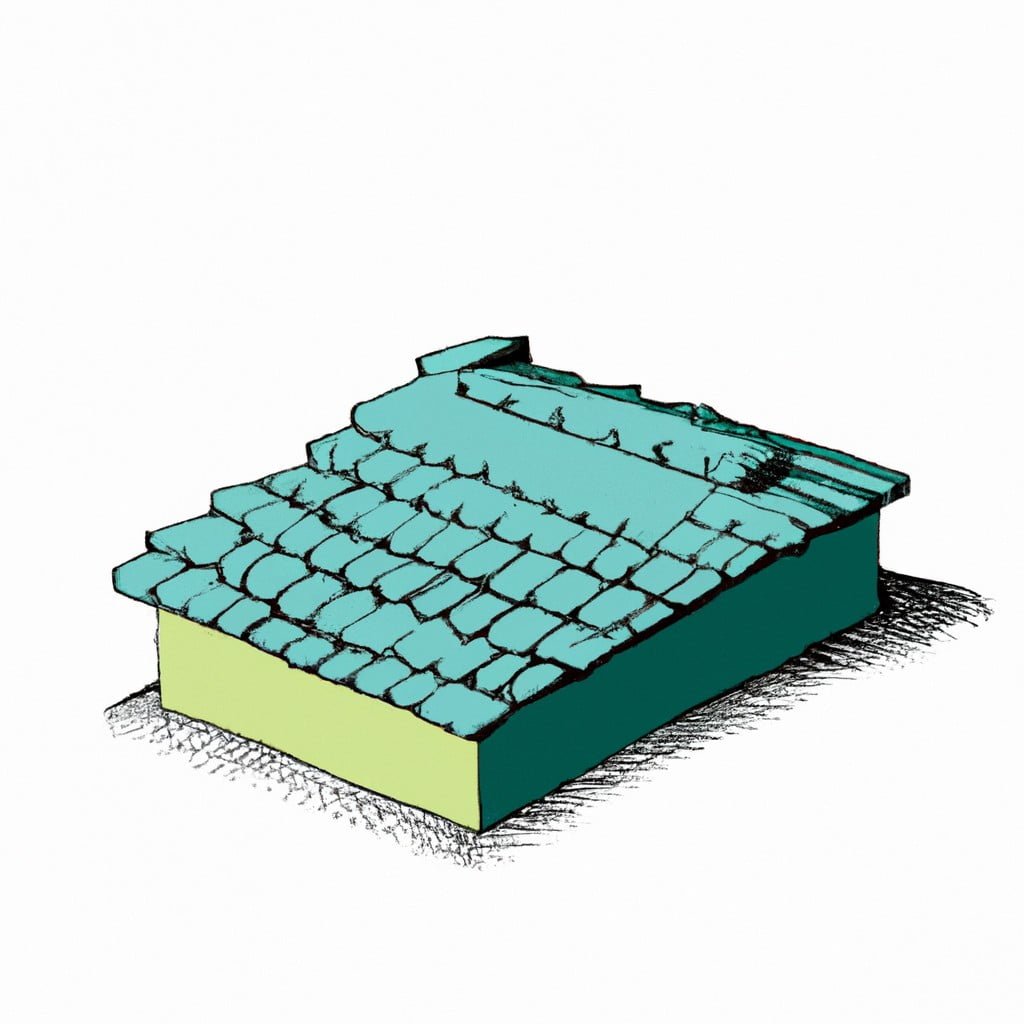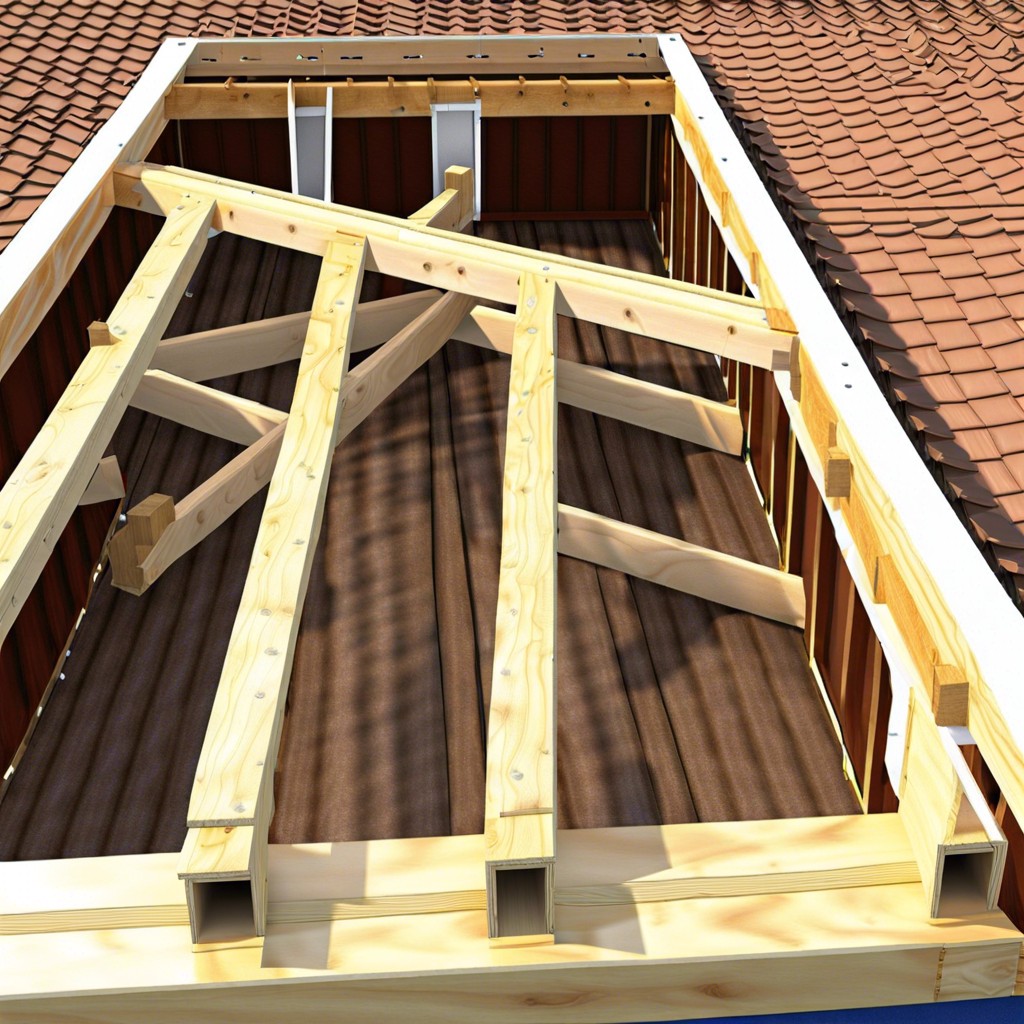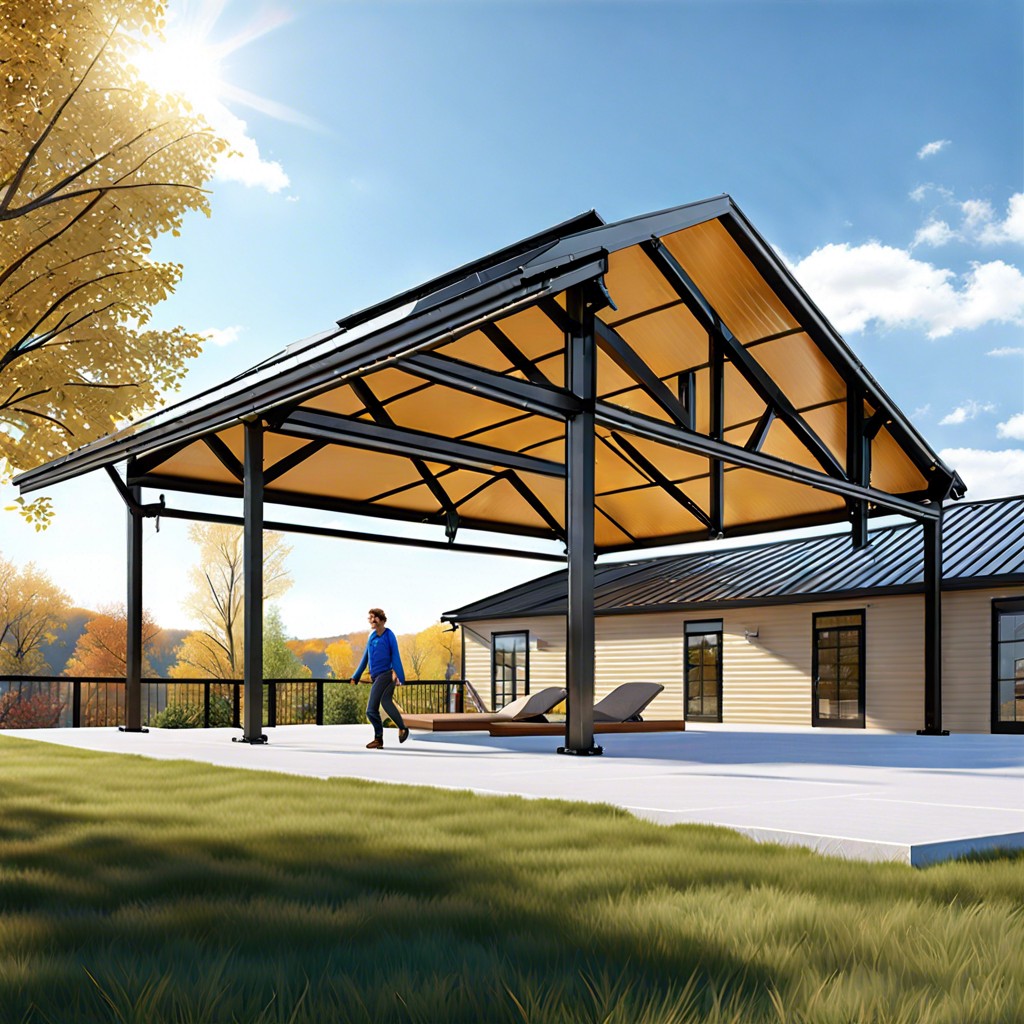Last updated on
Discover the essential techniques to safely and efficiently climb a steep roof, ensuring your protection while tackling this challenging task.
Have you ever wondered how roofers manage to climb steep roofs without falling? Climbing a steep roof can be daunting, especially for those who are not familiar with the right techniques. However, with the proper knowledge and tools, anyone can safely climb a steep roof.
In this article, we’ll share some tips and tricks on how to climb a steep roof like a pro. Whether you’re planning on doing some DIY roofing or just curious about the process, read on to learn more!
Safety Precautions

Safety should always be your top priority when climbing a steep roof. Before you even think about stepping onto the ladder, make sure to take all necessary safety precautions.
This includes wearing appropriate clothing and footwear, securing your tools and materials, setting up a rope and harness system or using a roof harness for added protection.
It’s also important to assess weather conditions before starting any work on the roof. Avoid working in extreme temperatures or during inclement weather such as rain or snow that can cause slippery surfaces.
Another crucial step is conducting an inspection of both the ladder and the roofing surface itself before beginning any climb. Check for damage on both surfaces that could compromise their stability while in use.
By taking these safety measures seriously, you’ll ensure not only your own well-being but also those around you who may be assisting with this task.
Assess Weather Conditions
Climbing on a wet or icy surface can be dangerous and increase the risk of slipping and falling. Check the weather forecast for your area before starting any roofing work.
If there is rain or snow in the forecast, it’s best to postpone your project until better weather conditions prevail.
Even if there isn’t precipitation predicted, you should still consider other factors such as wind speed and direction. Strong winds can make climbing more challenging by making ladders unstable or blowing tools off roofs.
It’s also important to note that extreme temperatures can affect both you and your equipment while working on a roof. High temperatures may cause heat exhaustion or dehydration while low temperatures may lead to hypothermia.
Roof Inspection
A proper inspection will help you identify any potential hazards and ensure that the roof is safe to climb. Start by checking for loose or missing shingles, cracks in the roofing material, and signs of water damage.
Inspecting your roof from ground level can be challenging since you may not see all areas of concern. Therefore, consider using binoculars or a drone camera to get an aerial view of your rooftop.
If possible, walk around on top of your home’s attic space with a flashlight during daylight hours while looking for any leaks or other issues that could cause problems down below over time.
Assess Roof Condition
This step is crucial as it helps you identify any potential hazards that may pose a risk while working on the roof. Start by checking for any loose or missing shingles, cracks in tiles or slates, and other signs of damage.
If you notice any significant damage to your roofing material during your inspection, consider calling in professional help before attempting to climb onto your rooftop. A damaged roof can be unstable and dangerous if not handled correctly.
Check for debris such as leaves or branches that may have accumulated on top of the surface over time. These items can make walking difficult and increase slip risks when wet.
Assessing your rooftop’s condition will give you an idea of what kind of work needs doing before starting repairs safely.
Necessary Tools
Having the necessary equipment will not only make your job easier but also ensure your safety while working at heights. Some of the essential tools that you’ll need include a ladder, roofing harness, rope and anchor system, and appropriate footwear.
When selecting a ladder for climbing steep roofs, choose one with adjustable legs that can be set at different angles to match the pitch of your roof. This feature ensures stability when working on an incline surface.
A roofing harness is another critical tool for anyone planning on climbing steep roofs. It helps prevent falls by securing you in place while allowing freedom of movement as needed.
Rope and anchor systems are also crucial when working on high-pitched roofs since they provide additional support in case of slips or falls.
Lastly, wearing appropriate footwear is vital when ascending any type of roof surface; shoes with good traction help prevent slipping accidents from occurring.
Ladder Selection
The ladder should be sturdy and long enough to reach the roof’s edge without leaning against it. A straight or extension ladder is ideal for this task as they provide stability and can be adjusted according to your needs.
Before choosing a ladder, consider its weight capacity and material. Aluminum ladders are lightweight but may not support heavy loads, while fiberglass ladders are more durable but heavier than aluminum ones.
It’s also essential to choose a ladder with non-slip rungs that will provide traction even when wet or covered in debris. Ensure that the feet of your chosen ladder have rubber pads or other anti-slip materials that will prevent them from sliding on smooth surfaces like tiles.
Use the Correct Size of Ladder
A ladder that’s too short or too long can be dangerous and unstable, making it difficult for you to climb up and down safely. Before selecting a ladder, measure the height of your roof from the ground level accurately.
Once you have determined how tall your roof is, choose a ladder that extends at least three feet above its edge. This will provide enough space for you to step onto the rooftop without losing balance or falling off.
It’s also essential to consider weight capacity when choosing a suitable size of ladders as some roofs may require heavier equipment than others. Always check with manufacturer guidelines before purchasing any equipment.
Remember always use an extension ladder instead of an A-frame one since they are more stable on uneven surfaces like sloping roofs.
Ladder Setup
The first step is to place your ladder on a flat surface and ensure that it is stable. If necessary, use a leveler or wedge under one of the legs to make sure that both sides are even.
Next, position your ladder at an angle of 75 degrees from the ground. This means that for every four feet in height, move out one foot from where you’re leaning against (4:1 ratio).
For example; if you want to climb onto a roof with an elevation of 16 feet high then place your base about four feet away from where you will lean against.
Make sure that both side rails are resting securely on solid surfaces such as walls or roofs before climbing up. Also avoid placing ladders near doors or windows which can be opened accidentally by someone inside while working outside.
Avoid Climbing Near a Power Line
One such hazard is power lines. Before you start climbing, take the time to assess the area around you for any overhead power lines that could pose a danger.
If there are power lines near your work area or above the roof, make sure they’re de-energized before starting work. If this isn’t possible, keep at least 10 feet away from them at all times and use non-conductive ladders made of fiberglass or wood instead of metal ones.
Remember that electricity can jump gaps if conditions are right; therefore, always assume that every wire is live unless confirmed otherwise by an electrician who has tested it with proper equipment.
Roof Anchor Installation
A roof anchor provides an attachment point for your rope and harness system, allowing you to move around the roof with ease and confidence.
To install a roof anchor, you’ll need to locate the rafters or trusses beneath the roofing material. Once located, drill pilot holes into these structural members using appropriate screws that are long enough to penetrate through both layers of sheathing (roof decking) and into the rafter/truss below.
Next, attach metal flashing over each hole before screwing down an L-shaped bracket onto each one. The brackets should be positioned so that they protrude above the surface of your roofing material by about 2 inches.
Secure D-rings onto each bracket using bolts or screws provided with them. These rings will serve as attachment points for ropes or lanyards used in conjunction with personal fall arrest systems (PFAS).
Rope and Harness System
It provides additional safety measures, ensuring that you remain secure while working on the roof. The rope and harness system consists of a full-body harness, lanyard, anchor point, and lifeline.
Before using the rope and harness system, ensure that it’s in good condition by inspecting it thoroughly for any signs of wear or damage. Make sure to use only high-quality equipment from reputable manufacturers.
When setting up your rope and harness system on the roof, choose an anchor point that can support at least 5 times your body weight. Securely attach your lifeline to this anchor point before putting on your full-body harness.
Once you’re ready to climb onto the roof with your ladder safely secured in place below you (as discussed earlier), connect yourself securely to the lifeline using a lanyard attached between two D-rings located at chest height or above.
Use a Roof Harness
A harness will keep you securely attached to the roof, preventing falls and injuries. Before starting any roofing work, make sure that your harness is properly fitted and adjusted.
To use a roof harness correctly, attach it to an anchor point on the rooftop using appropriate hardware such as D-rings or carabiners. The anchor point should be strong enough to support your weight in case of an accident.
Once you have secured yourself with the rope and harnessed system, move slowly along the surface of your rooftop while keeping both hands free for balance purposes only. Avoid carrying tools or materials while moving around on top of roofs because this can throw off your balance and increase risks associated with falling accidents.
Remember that wearing just any type of rope won’t do; ensure that you are using high-quality ropes designed specifically for roofing tasks since they are more durable than regular ropes used elsewhere.
Proper Footwear
The shoes you choose should provide excellent traction and grip on the surface of your roof. Avoid wearing shoes with smooth soles or high heels as they can cause slips and falls.
Instead, opt for rubber-soled work boots that have good tread patterns. These types of boots are designed to provide maximum grip on slippery surfaces like roofs.
Make sure your footwear fits well and is comfortable enough for extended periods of use. You don’t want to be distracted by uncomfortable or ill-fitting shoes while working at heights.
Wear Appropriate Clothing and Footwear
You need to wear comfortable clothes that allow you to move freely, but also protect your skin from the sun’s harmful rays. Avoid wearing loose-fitting clothes as they can get caught on something while you’re climbing, causing an accident.
When it comes to footwear, make sure you wear shoes with good traction and ankle support. The shoes should have non-slip soles that provide excellent grip on the roof surface.
Avoid wearing sandals or flip flops as they do not offer enough protection or stability for this type of work.
Consider investing in a pair of roofing boots specifically designed for working at heights; these boots come with features such as steel toes and shanks which provide extra protection against falling debris.
Work Area Preparation
This step is crucial as it ensures that your workspace is safe and free from any potential hazards. One of the first things you should do when preparing your work area is to clear debris out of your path.
Remove any objects such as branches, tools or equipment that may cause tripping or slipping hazards.
Ensure there are no loose shingles on the roof surface before starting work. Loose shingles can be dangerous and may cause accidents if stepped on accidentally while working.
It’s also important to check for any power lines near the roofline before beginning work in order to avoid electrocution risks.
Clear Debris Out of Your Path
Debris can be anything from loose shingles and nails to tree branches or leaves. These items can cause slips, trips, and falls that could lead to serious injuries.
To avoid accidents caused by debris on the roof surface, take some time before starting work to clear the area around where you’ll be working. Use a broom or brush with stiff bristles to sweep away any dirt or dust that may have accumulated on the surface.
If there are larger objects like tree branches in your way, use gloves and safety glasses when removing them from your path. Be sure not only to remove what is directly in front of you but also look ahead for potential hazards as well.
Material and Tool Management
This will help you avoid going up and down the ladder multiple times, which can be time-consuming and dangerous. Before starting your climb, make sure that all your tools are in good condition and securely fastened to your tool belt or harness.
It’s also important to keep track of any loose materials on the roof such as shingles or tiles. These items can easily slide off if not secured properly, causing damage or injury below.
Make sure that any debris is cleared out of your path before beginning work.
Proper material management includes having a plan for how you will transport heavy items like roofing sheets up onto the roof safely without risking injury from lifting too much weight at once.
Secure Your Tools
However, carrying tools while climbing can be challenging and dangerous if not done correctly. To avoid accidents caused by falling objects, secure your tools before starting work on the roof.
One way to secure your equipment is by using a tool belt or pouch that attaches securely around your waist or chest. This will keep all of your essential items within reach and prevent them from slipping out of pockets.
Another option is to use lanyards or tethers attached to each tool that you need for the job. These are then clipped onto an anchor point on the roof so they won’t fall off accidentally.
It’s also important always to check that any loose screws or nails in roofing materials are removed before beginning work as these could cause damage if dropped from height.
Communication With Team
It’s essential to have someone else present to help you in case of an emergency or if you need assistance. Before climbing the roof, make sure that your team member knows what they should do in case something goes wrong.
It’s also crucial to establish clear communication between yourself and your team member while on the roof. You can use hand signals or walkie-talkies for this purpose.
Moreover, it would be best if you had someone on the ground who can keep an eye out for any potential hazards such as power lines, falling debris, or other obstacles that may pose a threat while working on the rooftop.
Always ensure that there is open communication between yourself and your team members before starting work on any roofing project.
Always Have Another Person Present
This is especially important if you’re not an experienced roofer or if you’re working on a particularly challenging roof. Having someone else with you can provide an extra set of eyes and hands, making the job easier and safer.
Your partner can help by holding the ladder steady while you climb up, passing tools and materials up to you once on top of the roof, or even just being there in case something goes wrong. They should also be trained in basic safety procedures so that they know how to respond in case of an emergency.
Remember that accidents happen quickly, so it’s essential always to have someone nearby who can call for help or assist with first aid if needed. Even professional roofing companies require their workers never work alone but instead work as part of a team.
Having another person present when climbing steep roofs is crucial for your safety and well-being during this task. So make sure that before starting any roofing project involving heights; bring along someone who has experience working at height!
FAQ
What is the safest way to climb a steep roof?
The safest way to climb a steep roof is by walking sideways, placing both feet together with each step, and remaining crouched down slightly while descending.
How do you walk on a 45 degree roof?
To walk on a 45-degree roof, ensure you wear shoes or boots with grippy rubber soles, maintain your feet at waist height while ascending or descending, and always stand on solid material for safety.
What are the essential safety gear and equipment for climbing a steep roof?
Essential safety gear and equipment for climbing a steep roof include a secure ladder, proper footwear, safety harness, rope, and anchor points.
Which techniques can be used to maintain balance and stability on a steep roof?
Techniques to maintain balance and stability on a steep roof include using roof brackets, roof jacks, toe boards, and wearing proper footwear with good traction.
How can one assess the condition of the roof before starting the climbing process?
One can assess the condition of the roof before starting the climbing process by examining the roof visually, checking for any signs of damage, wear, or structural issues.




